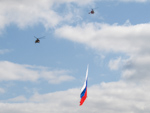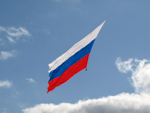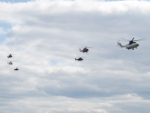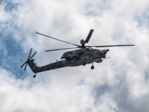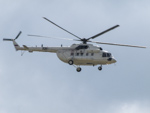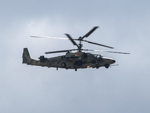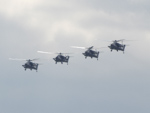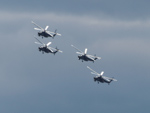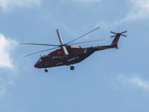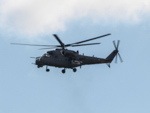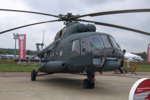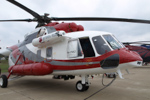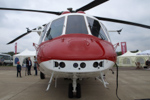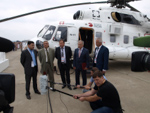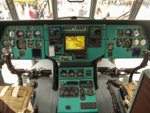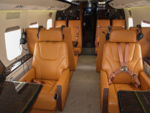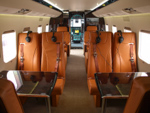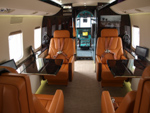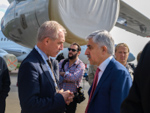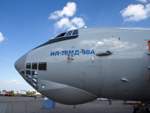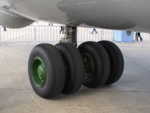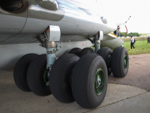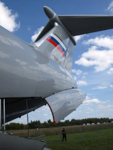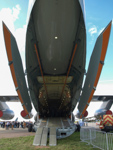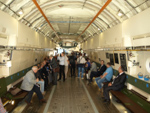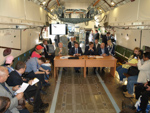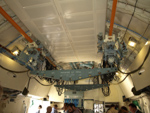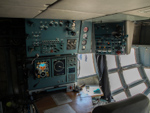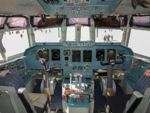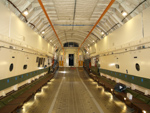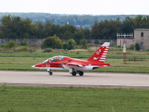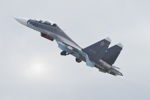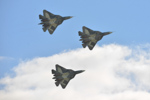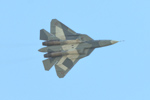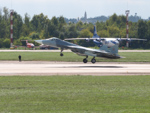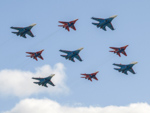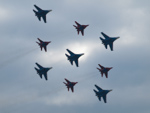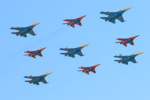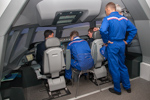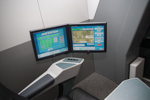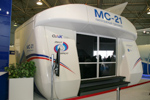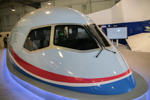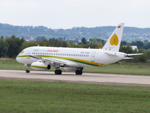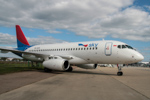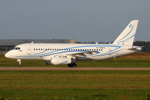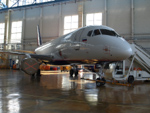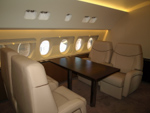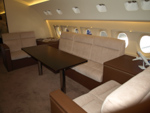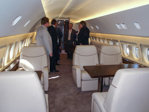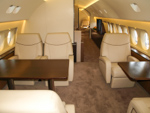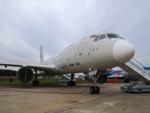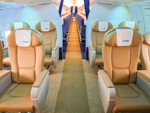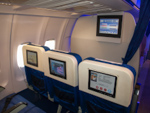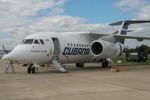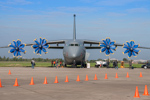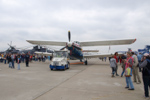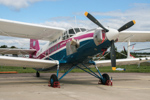The airshow of hopes
Despite the fact that the static display demonstrated at MAKS-2013 was more compact as compared to previous airshows, it left a more positive impression. I (and my colleagues) used to disparagingly call this part of the Ramenskoye airfield the “aviation museum”. Of course we don’t mean to treat the great history of Soviet aviation with indignity, but the outdated rusty aircraft brought here from the territory of Gromov Flight Research Institute just don’t belong at the major international forum. This year they reasonably confined themselves to one Tu-144 (the second one is corroding at the territory of Gromov Flight Research Institute with a cut-off engine cowls).
The share of state-of-the-art aircraft has increased dramatically both in quantitative and qualitative terms. So many newly-designed products and advanced developments have been demonstrated at MAKS airshow for the first time. That’s why I called it “the ai
The parade took place without the Commander-in-Chief
The president of Russia, Vladimir Putin, did not visit MAKS airshow for the first time in its history. It is hard to uncover the reasons for his absence. Some people believe that the president is unhappy with the results of United Aircraft Corporation’s (UAC) activities. And this version is quite probable. The results in the segment of civil aircraft are more than meager. And that is being kind. Shortly before the airshow the president had to personally address the issue of saving the most advanced project of the national aircraft industry (Sukhoi Superjet 100) from the bankruptcy. And the news from military aviation segment are not very optimistic too.
The prime-minister Dmitry Medvedev had to play the leading part at the airshow. However there was no solemn op
In fact after that it was safe to close the airshow: the country leader has already inspected the exhibition display, the contracts have been signed and mass media have already reported about it. But the most interesting part for us was only starting so let’s put away our sarcasm and a gall left in our mind by the inconvenience connected with the “presidential” day of MAKS airshow and speak about the exhibition display and business part of the airshow.
Helicopter boom
Russian Helicopters Holding Company presented not only all of its combat, transport and passenger vehicles at the airshow, but also demonstrated the long-awaited Ka-62 helicopter. It is our first hope of the airshow. It is unable to take part in the demonstration flights yet, but it is a real helicopter instead of a mock-up. And I must admit it is as good as its plastic model demonstrated on previous airshows. It is a beautiful helicopter and I hope that the serial vehicles will be as good as the prototype and will be successful at the global market.
The much-anticipated Mi-38 was the second star of the airshow. This vehicle participated in the demonstration flights and the visitors saw a great solo pilotage. Many people know that the vehicle was developed on the gridiron, but this is our industry’s hope for keeping the leading positions at the global market in heavy multi-role helicopter segment.
And these are by no means all the new helicopters. Almost all Russian-produced state-of-the-art helicopters took part in the demonstration flights. Epithets like “the most…” or “world’s only” may be used in description of every demonstrated vehicle. This refers to Mi-35M military transport helicopter, co-axial Ka-52 “Alligator”, Mi-28N “Havoc”, “the flying cow” Mi-26 (whose production has been resumed), unique Ka-32 and light Ansat.
And of course our industry’s particular highlight – Mi-8/17 Family presented at the airshow by a number of new modifications. In particular, Aviation Registry of the Interstate Aviation Committee (AR IAC) handed over the certificate for M-171 helicopter (intended for corporate and VIP transportation) to Russian Helicopters at MAKS airshow.
The demonstration flights performed by the helicopters, including a theatricalized occupation of terrorist base, were one of the flight program’s major zests. I believe that our helicopter industry deserved at least a solid B. Over the past two decades our industry did not waste its potential in this segment and even managed to increase it. It would be wrong to say that everything is going on swimmingly in this segment. However, the fact that the output of our helicopter industry is increasing (it has already reached 300 vehicles per year) speaks for itself. The enterprises have a solid backlog and every second helicopters is imported.
UAC’s aircraft
As I noted before, UAC prepared all of its contracts for the signing ceremony held on the opening day of MAKS-2013 in the presence of the prime-minister. You rarely get to see such an impressive participant list. Vice-premiers, ministers, leaders of state corporations and major banks (and their leasing subsidiaries), top-managers of UAC, etc. took part in the signing ceremony. The major part of these contracts was related to financing of sales of SSJ100 and MS-21 aircraft. A 3-year contract for maintenance of aircraft operated by Russian Ministry of Defense and Rostech’s contract with the government of Moscow Region, Russian Venture Company (RVC) and Vnesheconombank for establishment of Ramenskoe Tech Park have also been signed. In my opinion, the latter contract is the most interesting one in terms of journalism. We will keep track of this project.
As against the helicopter industry, the situation in aircraft segment is much worse. However, the airframers were able to present their latest products at MAKS. In my view Il-76MD-90A aircraft (Product-476) was the most important premiere of the airframers at the airshow. And no matter how much talk there is about the age of this vehicle, because it’s not like the old Il-76. In fact it is a proven and reliable solution with new capabilities. And the most important thing is that the jet’s production is being carried out by Russian enterprise. I will not describe all the new features and solutions, because there are a lot of articles dedicated to this topic. Anyway I believe that this is one of the most significant milestones achieved by national airframers during post-Soviet era. It seemed that our industry is unable to carry out such projects. But this one brings hope. The presentation of the jet was held on board the aircraft. President of UAC, Mikhail Pogosyan, delivered a speech in the presence of the governor of Ulyanovsk Region, Sergey Morozov, at the ceremony. The speech was dedicated to development prospects of the national transport aviation.
Another successful project of the national aircraft industry is Yak-130 operational trainer. The vehicle is successful and promising (touching wood). I am “placing” it in a coin box of our assets as well as Il-76MD-90A. Unfortunately, this is the last one. I don’t mean to take from the merit of such great aircraft as Su-35, MiG-35 and another modification of Su-30 but the future of combat aviation does not belong to them. Our only hopes rest upon the only advanced project – T-50. And we were glad to watch not only solo but also the formation flying performed by these jets. However, these are prototypes yet. There is still a long road ahead. We don’t want T-50 to suffer the same fate as Su-47.
The UAC’s progress in the civil aircraft segment is even more modest. Sukhoi Superjet 100, the aircraft which was thought to be a breakthrough product, is slowly becoming a “training aid” for the future breakout. Now MS-21 is believed to be a breakthrough product. The trainer for this aircraft type was presented at the airshow. The Superjet was represented by several serial vehicles, including its LR (long range) version intended for Gazpromavia and VIP-version with the Rosoboronexport’s logo. In fact this is just a concept of a VIP-cabin instead of a real one.
Generally there are no real hopes in the civil aircraft segment, only promises and frustrations. There is no project to be proud of. Maybe that is the reason why foreign airframers are taking a relaxed look at our efforts. According to the latest Boeing’s forecast, the global market will require more than 35000 civil aircraft over the next 20 years. If Russia delivers at least 1000 aircraft during this period, this will be a significant achievement. But at the same time this will be just a 1/35 (or 3%) of the market. If we can deliver more aircraft, it will be a great success. But the western countries are not afraid of it. We remind you that the output of the world’s leading enterprises is 1,5-2 aircraft per day.
Stepsons, cousins and a brother-in-law
There was one more aircraft presented by UAC at the airshow – Tu-204SM. The jet turned out to be much more interesting than I thought. Unfortunately it is hard to overlook the fact that UAC treats it like a “stepson”. There is not much information about the airliner. Despite the fact that two contracts for delivery of these jets to VIM Airlines and Red Wings have been signed at MAKS-2013 airshow the powerful advertising department of UAC seems to ignore it. Not a single representative of UAC has visited the abovementioned signing ceremonies. The fans of this jet are glad but the signed contracts do not grant the vehicle’s future. The implementation of these contracts is impossible without the support of UAC’s leaders. So it does not matter how many contracts have been signed...
Our Ukrainian colleagues have traditionally brought a significant number of aircraft to the MAKS airshow. Kiev-based Antonov State Enterprise and Motor Sich (Zaporozhye) are among few efficient enterprises of the industry in CIS Region. They have presented An-148, An-158, An-70 and An-2-100 (the upgraded version of An-2). For now the Kiev-based design bureau outscores the whole Russian aircraft industry, which has advantage in terms of financing and number of enterprises. Russian-Ukrainian An-148/158 project is truly a success of Antonov and one more hope for us. Unfortunately, the future of this project bumps up against the limited capabilities of Russian enterprises. And UAC’s attitude to the project leaves much to be desired. The capabilities of Kiev-based enterprise are also limited. The third jet of the type was handed over to Cubana airline (Cuba) at MAKS-2013.
The military-transport An-70 aircraft was another highlight of the flight program at MAKS-2013. Unfortunately, this long-suffering project became the hostage of political plays of Moscow and Kiev. And every party has its own facts. But one thing is absolutely clear – the aircraft’s state testing has not been completed yet and the working design documentation has not been handed over to a Kazan-based enterprise.
Another interesting product is the re-engined An-2-100 powered by MS-14 turboprop engine manufactured in Zaporozhye. This aircraft as well as its Russian analogue (TVS-2MS powered by Honeywell TPE331-12 turboprop engine) has demonstrated its capabilities. Both vehicles have a very short takeoff distance and thanks to negative thrust propeller they land almost like helicopters do. Interesting vehicles and a great decision – to extend the life of many An-2s able to serve the national economy for years to come.

The signing of an agreement between Rostech and Bombardier for launching the licensed production of Q400 aircraft in Russia was the subject of wide speculation. Regrettably, the UAC’s marketing experts thought earlier that production of regional aircraft has no chances to succeed and decided not to develop the aircraft of this class. As a result the only aircraft in this class which is being produced in Russia is An-140. It is an interesting jet, but there are some problems in terms of its quality, reliability and maintenance costs. It is being manufactured by Samara-based Aviacor (not UAC’s enterprise). Meanwhile Russian market needs more jets of the type. National airlines are replacing the aircraft manufactured in USSR by the new ones. That is why I find the desire to take part in production of foreign aircraft instead of just purchasing it quite reasonable. And Q400 is the best “candidate”.
And I must admit that there were a lot of general aviation aircraft presented at the show. Many of my friends interested in such vehicles told me that this MAKS gave them some hopes too.
And even the long-suffering Rysachok, who seemed to be buried by Russian officials, is enjoying resurgence – it was demonstrated at the airshow in the livery of Russian air forces.

Organization of the airshow
And now I would like to say a few words about the organization of the airshow. For the first time in many years the first 4 days of MAKS did not caused any reasons for negative emotions. There were no traffic jams, no queues at the entrance and the show was working without any mishaps. Only traditional problems with internet and mobile services remained the same. But this problem is caused by the low development level of communications in Moscow Region. But the situation, which happened on the fifth day, just blows my mind. The total un-co-operation of police and transport services caused the real collapse. As a result thousands of visitors spent several hours in the pouring rain without any possibility of leaving the airshow. These are the questions for regional authorities.
And the traditional complaints against the actions of the Federal Protective Service during the first day of MAKS-2013: it is unclear why did they flush the accredited journalists from the press-center and block its work assuming that the prime-minister had no intension of visiting it? At the same time, the security arrangements in the Congress-center, where Dmitry Anatolievich delivered a speech, were much more liberal. In many places the cordon was set after the prime-minister’s visit. Honestly speaking I felt ashamed seeing our confused foreign colleagues trying to figure out the situation. A situation when a group of Chinese journalists sat at the grass near the press-center and tried in vain to connect to the non-working Wi-Fi was the apotheosis of the absurd.
Anyway I would like to finish my story with some positive words. For the first time in many years the airshow did not left any bad feelings and gave us some hopes instead. MAKS-2015 will show us if these hopes will turn into reality. See you next time!

